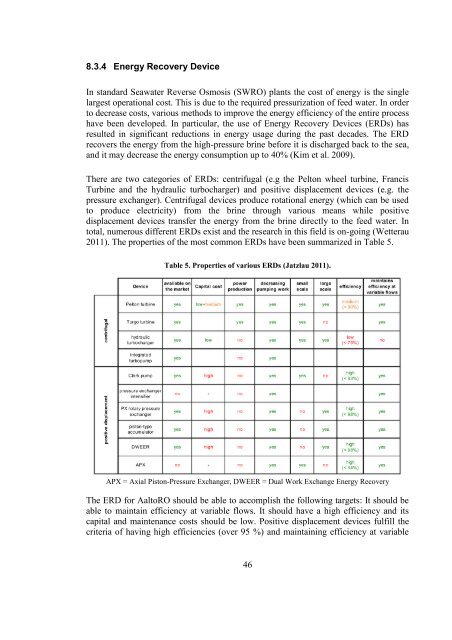A Feasibility Study - Aaltodoc - Aalto-yliopisto
A Feasibility Study - Aaltodoc - Aalto-yliopisto
A Feasibility Study - Aaltodoc - Aalto-yliopisto
You also want an ePaper? Increase the reach of your titles
YUMPU automatically turns print PDFs into web optimized ePapers that Google loves.
8.3.4 Energy Recovery Device<br />
In standard Seawater Reverse Osmosis (SWRO) plants the cost of energy is the single<br />
largest operational cost. This is due to the required pressurization of feed water. In order<br />
to decrease costs, various methods to improve the energy efficiency of the entire process<br />
have been developed. In particular, the use of Energy Recovery Devices (ERDs) has<br />
resulted in significant reductions in energy usage during the past decades. The ERD<br />
recovers the energy from the high-pressure brine before it is discharged back to the sea,<br />
and it may decrease the energy consumption up to 40% (Kim et al. 2009).<br />
There are two categories of ERDs: centrifugal (e.g the Pelton wheel turbine, Francis<br />
Turbine and the hydraulic turbocharger) and positive displacement devices (e.g. the<br />
pressure exchanger). Centrifugal devices produce rotational energy (which can be used<br />
to produce electricity) from the brine through various means while positive<br />
displacement devices transfer the energy from the brine directly to the feed water. In<br />
total, numerous different ERDs exist and the research in this field is on-going (Wetterau<br />
2011). The properties of the most common ERDs have been summarized in Table 5.<br />
Table 5. Properties of various ERDs (Jatzlau 2011).<br />
APX = Axial Piston-Pressure Exchanger, DWEER = Dual Work Exchange Energy Recovery<br />
The ERD for <strong>Aalto</strong>RO should be able to accomplish the following targets: It should be<br />
able to maintain efficiency at variable flows. It should have a high efficiency and its<br />
capital and maintenance costs should be low. Positive displacement devices fulfill the<br />
criteria of having high efficiencies (over 95 %) and maintaining efficiency at variable<br />
46
















